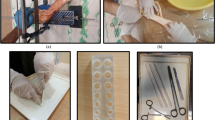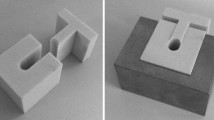Abstract
For ACL reconstruction, interference screw can fix the graft in the bone tunnel closer to the articular surface. However, direct interference screw fixation has a possibility to damage the tendon graft at the time of screw insertion, and the bone–tendon contact area is limited within the tunnel. To avoid the damage to the tendon graft at the time of screw insertion and to increase the bone–tendon contact area, a free bone plug was interposed between screw and tendon graft (indirect interference screw fixation). The purpose of this study was to compare ultimate load strength and histological findings between two techniques in a rabbit model. Ultimate pull-out load tests and histological examinations were evaluated at time 0, 3 and 6 weeks. The ultimate failure load of indirect interference screw fixation was significantly higher than that of direct interference screw fixation immediately after surgery (P < 0.05). Histologically, the interface tissues between tendon graft and host bone were more organized and matured in indirect technique. These findings showed that indirect interference screw fixation for tendon graft increased fixation strength at the graft–bone interface, providing quicker graft–bone healing.





Similar content being viewed by others
References
Aglietti P, Buzzi R, D’Andria S, Zaccherotti G (1993) Patellofemoral problems after intraarticular anterior cruciate ligament reconstruction. Clin Orthop 288:195–204
Aglietti P, Buzzi R, Zaccherotti G, De Biase P (1994) Patellar tendon versus doubled semitendinosus and gracilis tendons for anterior cruciate ligament reconstruction. Am J Sports Med 22:211–218
Anderson AF, Snyder RB, Lipscomb AB Sr (1994) Anterior cruciate ligament reconstruction using the semitendinosus and gracilis tendons augmented by the losee iliotibial band tenodesis. A long-term study. Am J Sports Med 22:620–626
Brown CH Jr, Steiner ME, Carson EW (1993) The use of hamstring tendons for anterior cruciate ligament reconstruction. Technique and results. Clin Sports 12:723–756
Frank CB, Jackson DW (1997) The science of reconstruction of the anterior cruciate ligament. J Bone Joint Surg 79A:1556–1576
Fu FH, Bennett CH, Lattermann C, Ma CB (1999) Current trends in anterior cruciate ligament reconstruction. Part I: Biology and biomechanics of reconstruction. Am J Sports Med 27:821–830
Fu FH, Bennett CH, Ma CB, Menetrey J, Lattermann C (2000) Current trends in anterior cruciate ligament reconstruction. Part II: Operative procedures and clinical correlations. Am J Sports Med 28:124–130
Grana WA, Egle DM, Mahnken R, Goodhart CW (1994) An analysis of autograft fixation after anterior cruciate ligament reconstruction in a rabbit model. Am J Sports Med 22:344–351
Ishibashi Y, Rudy TW, Livesay GA, Stone JD, Fu FH, Woo SL (1997) The effect of anterior cruciate ligament graft fixation site at the tibia on knee stability. Arthroscopy 13:177–182
Liu SH, Panossian V, Al-Shaikh R, Tomin E, Shepherd E, Finerman GA, Lane JM (1997) Morphology and matrix composition during early tendon to bone healing. Clin Orthop 339:253–260
Nebelung W, Becker R, Urbach D, Ropke M, Roessner A (2003) Histological findings of tendon-bone healing following anterior cruciate ligament reconstructuion with hamstring grafts. Arch Orthop Trauma Surg 123:158–163
Park MJ, Lee MC, Seong SC (2001) A comparative study of the healing of tendon autograft and tendon-bone autograft using patellar tendon in rabbits. Int Orthop 25:35–39
Rodeo SA, Arnoczky SP, Torzilli PA, Hidaka C, Warren RF (1993) Tendon-healing in a bone tunnel: a biomechanical and histologic study in a dog. J Bone Joint Surg 75A:1795–1803
Shelbourne KD, Nitz P (1990) Accelerated rehabilitation after anterior cruciate ligament reconstruction. Am J Sports Med 18:292–299
Simonian PT, Sussmann PS, Baldini TH, Crockett HC, Wickiewicz TL (1998) Interference screw position and hamstring graft location for anterior cruciate ligament reconstruction. Arthroscopy 14:459–464
Weiler A, Hoffmann RF, Bail HJ, Rehm O, Sudkamp NP (2002) Tendon healing in a bone tunnel. Part II: Histologic analysis after biodegradable interference fit fixation in a model of anterior cruciate ligament reconstruction in sheep. Arthroscopy 18:124–135
Acknowledgments
We acknowledge the assistance of Prof. Yuji Tanabe, Department of Mechanical and Production Engineering, Niigata University, Niigata, Japan for biomechanical testing.
Author information
Authors and Affiliations
Corresponding author
Rights and permissions
About this article
Cite this article
Tomihara, T., Ohashi, H. & Yo, H. Comparison of direct and indirect interference screw fixation for tendon graft in rabbits. Knee Surg Sports Traumatol Arthr 15, 26–30 (2007). https://doi.org/10.1007/s00167-006-0118-6
Received:
Accepted:
Published:
Issue Date:
DOI: https://doi.org/10.1007/s00167-006-0118-6




